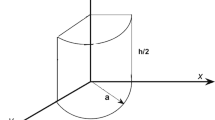Abstract.
This paper addresses the complexity of computing the smallest-radius infinite cylinder that encloses an input set of n points in 3-space. We show that the problem can be solved in time O(n 4 logO(1) n) in an algebraic complexity model. We also achieve a time of O(n 4 L⋅μ(L)) in a bit complexity model where L is the maximum bit size of input numbers and μ(L) is the complexity of multiplying two L bit integers.
These and several other results highlight a general linearization technique which transforms nonlinear problems into some higher-dimensional but linear problems. The technique is reminiscent of the use of Plücker coordinates, and is used here in conjunction with Megiddo's parametric searching.
We further report on experimental work comparing the practicality of an exact with that of a numerical strategy.
Similar content being viewed by others
Author information
Authors and Affiliations
Additional information
Received September 10, 1997; revised August 28, 1988.
Rights and permissions
About this article
Cite this article
Schömer, E., Sellen, J., Teichmann, M. et al. Smallest Enclosing Cylinders . Algorithmica 27, 170–186 (2000). https://doi.org/10.1007/s004530010011
Issue Date:
DOI: https://doi.org/10.1007/s004530010011




